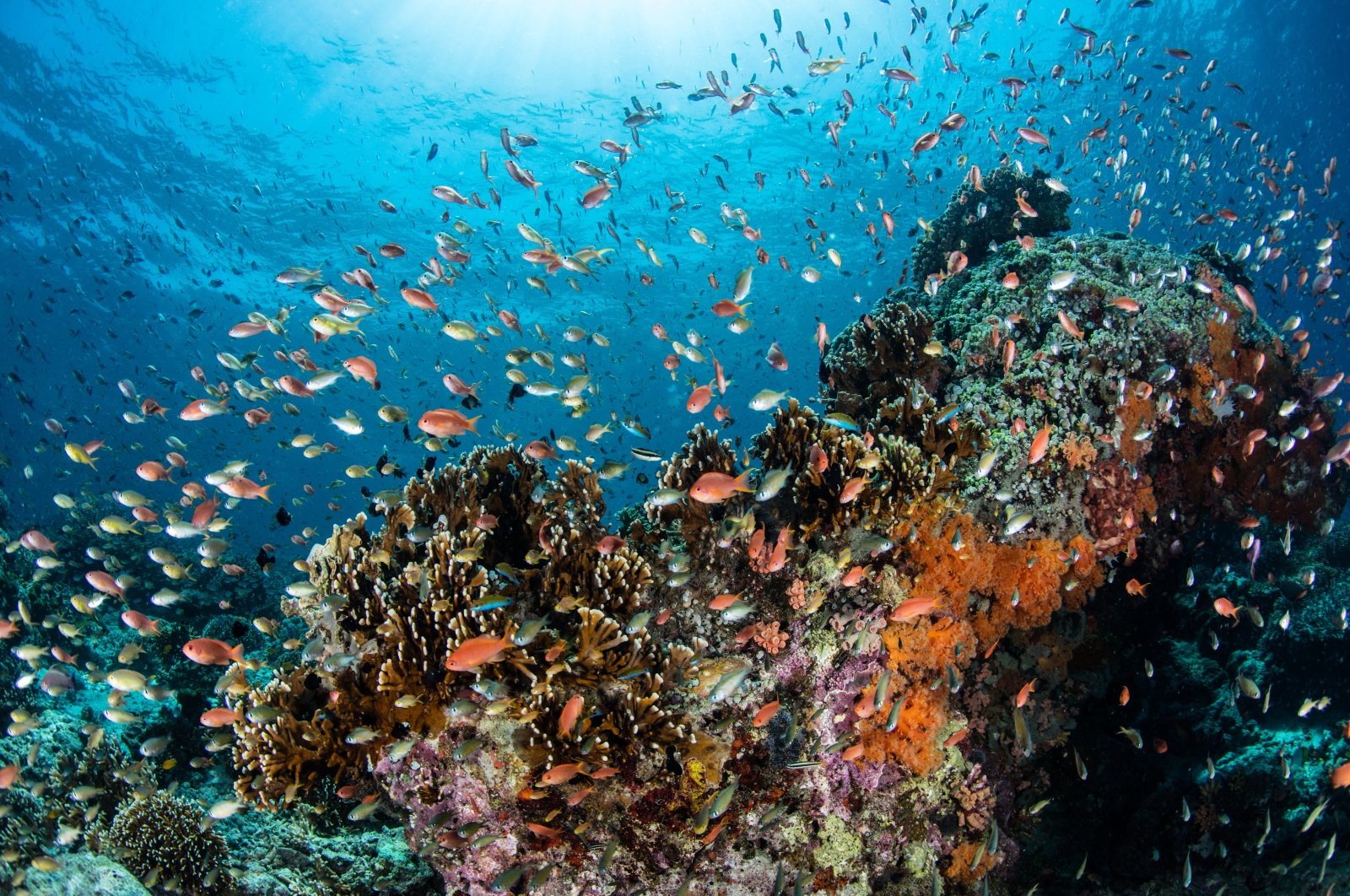Climate change intensifies loss of biodiversity in Türkiye
Climate change intensifies loss of biodiversity in Türkiye | Daily Sabah Daily Sabah


The Urgent Need to Address Biodiversity Loss and Climate Change

The far-reaching consequences of climate change are now taking a toll on natural ecosystems and living species, ringing alarm bells for both biodiversity and human life. A recent report by WWF-Türkiye (World Wildlife Fund) highlighted the grave danger faced by Mediterranean fish species, where a staggering 60% of fish species are on the brink of extinction, with many teetering on the edge of oblivion.
The Impact of Climate Change on Mediterranean Fish Species
Özge Balkız, the Nature Conservation Center Biological Diversity Conservation Program coordinator, attributed this dire situation to the looming threat of climate change, which poses a significant risk to species’ abilities to adapt to their changing environments. Even a mere 1 degree Celsius (1.8 degree Fahrenheit) increase in global temperatures can have severe consequences, impacting the genetics, behavior and survival abilities of various living beings. The escalating consequences of human activities, rising sea levels, soaring air temperatures and food shortages have left many species with no choice but to migrate in search of suitable habitats.
The Global Extinction Crisis
A staggering 28% of species worldwide, encompassing approximately 42,108 out of 150,388 species evaluated by the International Union for the Conservation of Nature (IUCN), are facing the ominous specter of extinction. The ecological shifts induced by rising air temperatures are affecting migration routes for chinook salmon and altering the breeding times of tree swallows. Moreover, high temperatures during the spawning process are leading to an unbalanced sex distribution in the offspring of green sea turtles, a species that is already under grave threat of extinction. Studies have revealed that a staggering 99% of newly hatched green sea turtles are now female due to these rising temperatures.
The Impact on Türkiye’s Biodiversity
Balkız warned that losing biodiversity is estimated to be between 50% to 75%, with certain regions of Türkiye experiencing significant declines as well. She emphasizes that many species of butterfly in Türkiye, with limited mobility and adaptation capacity, are disproportionately impacted compared to more generalist species.
The Link Between Biodiversity Loss and Human Welfare
Highlighting the repercussions of biodiversity loss, Balkız stressed that the consequences extend beyond plants and animals to directly affect human life. Natural ecosystems and the myriad creatures they support play a vital role in the battle against climate change and impact human well-being. Hence, addressing biodiversity loss is intrinsically linked to safeguarding human welfare.
The Importance of Taking Action
In the quest to combat climate change, the Intergovernmental Panel on Climate Change (IPCC) employs various measures to assess the extent of biodiversity loss due to temperature changes. Balkız asserted that species have developed diverse defense mechanisms to cope with the increasing air temperatures, leading to variations in the distribution of mobile species.
The urgency to act is clear, as climate change could lead not only to population declines but also the complete disappearance of certain species. Those living in deteriorating habitats with limited access to food face the gravest threats. Balkız pointed out that species with high adaptability and mobility possess a more significant advantage in surviving these environmental challenges.
The Role of Sustainable Development Goals (SDGs)
Balkız also underscored the crucial role of the Paris Agreement’s goals to limit temperature increases to 1.5 degrees. Transitioning to greener energy sources and making substantial investments in sustainability are paramount. Simultaneously, expanding terrestrial and marine protected areas to 30% under the International Convention on Biological Diversity, of which Türkiye is a member, is vital for species protection.
Actions to Preserve Biodiversity
Balkız advocated for reducing human activities that endanger biodiversity, adopting eco-friendly agricultural practices, making sustainable energy investments, transforming consumption habits and establishing conservation areas for species. With concerted efforts, we can still strive to preserve our planet’s rich biodiversity and ensure a sustainable future for all living beings.
SDGs, Targets, and Indicators
| SDGs | Targets | Indicators |
|---|---|---|
| SDG 13: Climate Action | Target 13.1: Strengthen resilience and adaptive capacity to climate-related hazards and natural disasters | Indicator not mentioned in the article |
| SDG 14: Life Below Water | Target 14.2: Sustainably manage and protect marine and coastal ecosystems to avoid significant adverse impacts, including by strengthening their resilience | Indicator not mentioned in the article |
| SDG 15: Life on Land | Target 15.5: Take urgent and significant action to reduce the degradation of natural habitats, halt the loss of biodiversity, and protect and prevent the extinction of threatened species | Indicator not mentioned in the article |
| SDG 15: Life on Land | Target 15.9: By 2020, integrate ecosystem and biodiversity values into national and local planning, development processes, poverty reduction strategies, and accounts | Indicator not mentioned in the article |
1. Which SDGs are addressed or connected to the issues highlighted in the article?
- SDG 13: Climate Action
- SDG 14: Life Below Water
- SDG 15: Life on Land
The article discusses the far-reaching consequences of climate change on natural ecosystems and living species, highlighting the grave danger faced by Mediterranean fish species and the overall threat of extinction to various species worldwide. These issues are directly connected to SDG 13, which focuses on climate action, as well as SDG 14 and SDG 15, which aim to protect life below water and life on land, respectively.
2. What specific targets under those SDGs can be identified based on the article’s content?
- Target 13.1: Strengthen resilience and adaptive capacity to climate-related hazards and natural disasters
- Target 14.2: Sustainably manage and protect marine and coastal ecosystems to avoid significant adverse impacts, including by strengthening their resilience
- Target 15.5: Take urgent and significant action to reduce the degradation of natural habitats, halt the loss of biodiversity, and protect and prevent the extinction of threatened species
- Target 15.9: By 2020, integrate ecosystem and biodiversity values into national and local planning, development processes, poverty reduction strategies, and accounts
Based on the article’s content, the specific targets under the identified SDGs include strengthening resilience to climate-related hazards and natural disasters (Target 13.1), sustainably managing and protecting marine and coastal ecosystems (Target 14.2), taking urgent action to reduce habitat degradation and prevent species extinction (Target 15.5), and integrating ecosystem and biodiversity values into planning and development processes (Target 15.9).
3. Are there any indicators mentioned or implied in the article that can be used to measure progress towards the identified targets?
No specific indicators are mentioned or implied in the article that can be used to measure progress towards the identified targets. The article focuses more on the issues and consequences of climate change on biodiversity rather than providing measurable indicators.
4. SDGs, Targets, and Indicators
| SDGs | Targets | Indicators |
|---|---|---|
| SDG 13: Climate Action | Target 13.1: Strengthen resilience and adaptive capacity to climate-related hazards and natural disasters | Indicator not mentioned in the article |
| SDG 14: Life Below Water | Target 14.2: Sustainably manage and protect marine and coastal ecosystems to avoid significant adverse impacts, including by strengthening their resilience | Indicator not mentioned in the article |
| SDG 15: Life on Land | Target 15.5: Take urgent and significant action to reduce the degradation of natural habitats, halt the loss of biodiversity, and protect and prevent the extinction of threatened species | Indicator not mentioned in the article |
| SDG 15: Life on Land | Target 15.9: By 2020, integrate ecosystem and biodiversity values into national and local planning, development processes, poverty reduction strategies, and accounts | Indicator not mentioned in the article |
Behold! This splendid article springs forth from the wellspring of knowledge, shaped by a wondrous proprietary AI technology that delved into a vast ocean of data, illuminating the path towards the Sustainable Development Goals. Remember that all rights are reserved by SDG Investors LLC, empowering us to champion progress together.
Source: dailysabah.com

Join us, as fellow seekers of change, on a transformative journey at https://sdgtalks.ai/welcome, where you can become a member and actively contribute to shaping a brighter future.







